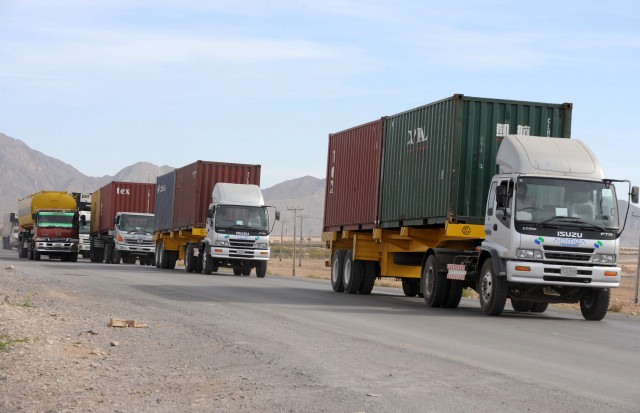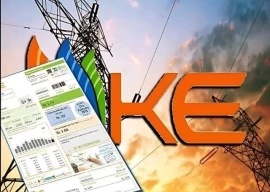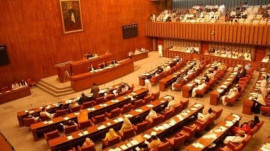
In the report on progress towards Afghanistan’s stability and security that is based on events from October 2011 to March 2012 and has been submitted to Congress, the Department of Defense says that the closure of the Pakistan Ground Lines of Communication (GLOCs) remains a strategic concern. “Failure to settle the GLOC issue will also significantly degrade redeployment and retrograde operations in support of the drawdown of coalition forces.”
The report cites the impact the closure of the Nato supply routes has had on equipment needs for Afghan forces. The Nato supply routes were closed in October 2011, after 24 Pakistani soldiers were killed in a Nato strike on the Pak-Afghan border.
The Afghan National Police remains under-equipped, says the report, and there will be shortages of equipment especially vehicles for Afghan National Army (ANA) units due to the closure of the GLOCs. Over 4000 vehicles meant to be used for the ANA, said the DoD report, remain stranded in Pakistan. “Reopening the GLOCs would improve the US and coalition forces' mission flexibility and build capacity.”
US forces in Afghanistan have been relying primarily on the Northern Distribution Network (NDN) through Central Asian nations for sending supplies to forces. The report says that it has “ensured the sustainment needs of coalition forces and allowed initial proof of principle shipments for retrograding material from Afghanistan to the United States” through the NDN.
However, “the closure of the GLOCs has had a more limited effect on communications equipment and weapons, the delivery of which continues via air lines of communication (ALOCs). Fielding priorities for the next 180 days are expected to be met if Pakistani GLOCs are restored.”
The closure of the GLOCs has also had an impact on the completion of the Kandahar-Helmand Power Plant program, and has created a backlog of electrical materials required for the project, says the report. DoD says that unless the border reopens or alternate routes are used, which will increase the cost of the project, the US could see a “potentially one-year delay in getting Kandahar distribution upgrade materials in the country.”
Safe havens in Pakistan
The DoD report says that the insurgent safe havens in Pakistan including the Haqqani network’s presence in North Waziristan are among the reasons why the security situation in eastern Afghanistan remains volatile.
The report also said that while attacks decreased by eight percent as opposed to the same time last year, 34% of all attacks in the country were in eastern Afghanistan, which had increased by 3% as opposed to the same period last year.
The report also calls safe havens in Pakistan and the “limited capacity of the Afghan government” as the biggest risks to Afghanistan’s security and transforming the state into a durable and sustainable one. Additionally, the report says that Kandahar remains a contested province in Afghanistan, partly due to the “insurgent safe havens and freedom of movement across the border in Pakistan's Balochistan province.”
“The insurgency benefits from safe havens inside Pakistan with notable operational and regenerative capacity. The insurgency remains a resilient and determined enemy and will likely attempt to regain lost ground and influence this spring and summer through assassinations, intimidation, high-profile attacks, and the emplacement of improvised explosive devices (IEDs). Additionally, the Afghan Government continues to face widespread corruption that limits its effectiveness and legitimacy and bolsters insurgent messaging.”
“Pakistan’s selective counterinsurgency operations, passive acceptance - and in some cases, provision - of insurgent safe havens, and unwillingness to interdict material such as IED components, continue to undermine security in Afghanistan and threaten ISAF’s campaign.”
While citing meetings between Afghanistan and Pakistan’s leadership, the report says, “pervasive mistrust, long-standing tensions, and divergent strategic interests continue to make genuine cooperation difficult.”
“Pakistan continues to seek a stable, secure Afghanistan, an Afghan government with primacy for Pashtuns, and limited Indian influence. To this end, Pakistan has allowed an insurgent sanctuary in its border areas to persist, offering a safe haven to Afghan Taliban and associated militant groups including the Haqqani Taliban Network in North Waziristan Agency. Pakistani leaders have tolerated this due to their concerns that Pakistan will be left alone to confront an unstable, an unfriendly, or an Indian-influenced Afghanistan on its borders. Accordingly, Pakistan seeks to play a key role in the peace and reconciliation process to advance a political settlement that considers Pakistani interests.”
Al Qaeda relying on Haqqani leaders
The Department of Defense report also says that even though al Qaeda has been degraded, it is increasingly relying on a “shrinking cadre of experienced leaders primarily inside a Haqqani-facilitated safe haven in North Waziristan.”
“The insurgency’s funding comes “from a variety of external sources, including Persian Gulf-based donors, state and non-state actors in Pakistan and Iran, and various transnational and criminal enterprises, but remains dependent on poppy cultivation and the narcotics trade as its primary source of revenue. Insurgents suspend operational efforts to provide labour for the poppy harvest, which typically begins in April and continues to June, as revenue from the poppy harvest is critical to insurgent operations throughout the year.”
Pakistan-based outfits, said the report, also support the insurgency through sanctuary, training infrastructure, and financial and operational support. “The insurgency also receives material support from Iran, although to a lesser degree than from Pakistan.” The report cites the corridor from Pakistan’s Kurram Agency through Azra District as the most vulnerable area in the east of Afghanistan.
The report says that the implementation of the Afghan-Pakistan Transit Trade Agreement has not been realised due to political tensions between Pakistan and India.


















COMMENTS
Comments are moderated and generally will be posted if they are on-topic and not abusive.
For more information, please see our Comments FAQ